Ladder-like Polymer Brushes Containing Conjugated Poly(Propylenedioxythiophene) Chains
Abstract
:1. Introduction
2. Results and Discussion
2.1. Synthesis of ProDOT-MM Monomer
2.2. Surface-Initiated Atom Transfer Radical Polymerization
2.3. Oxidative Polymerization
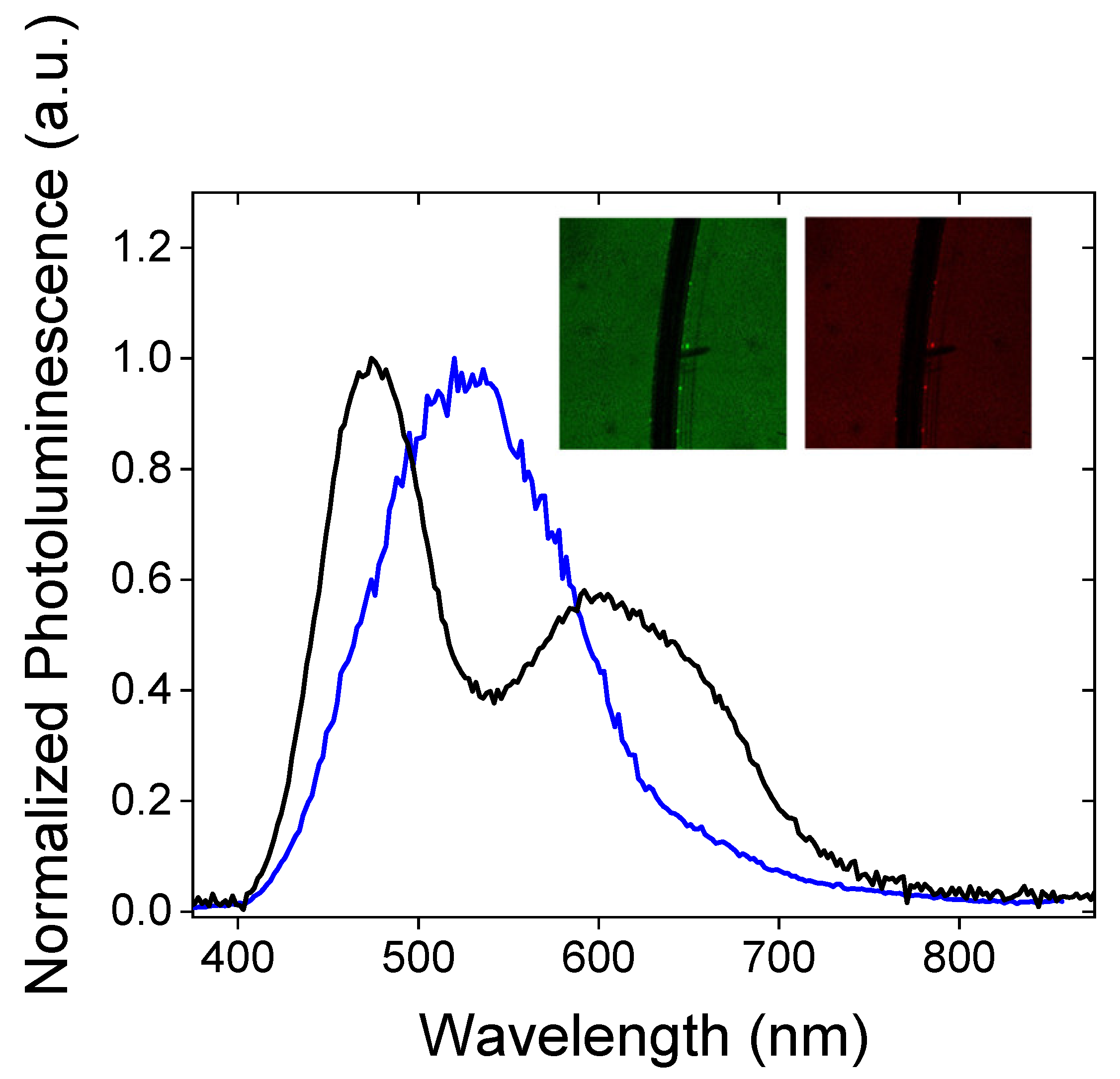
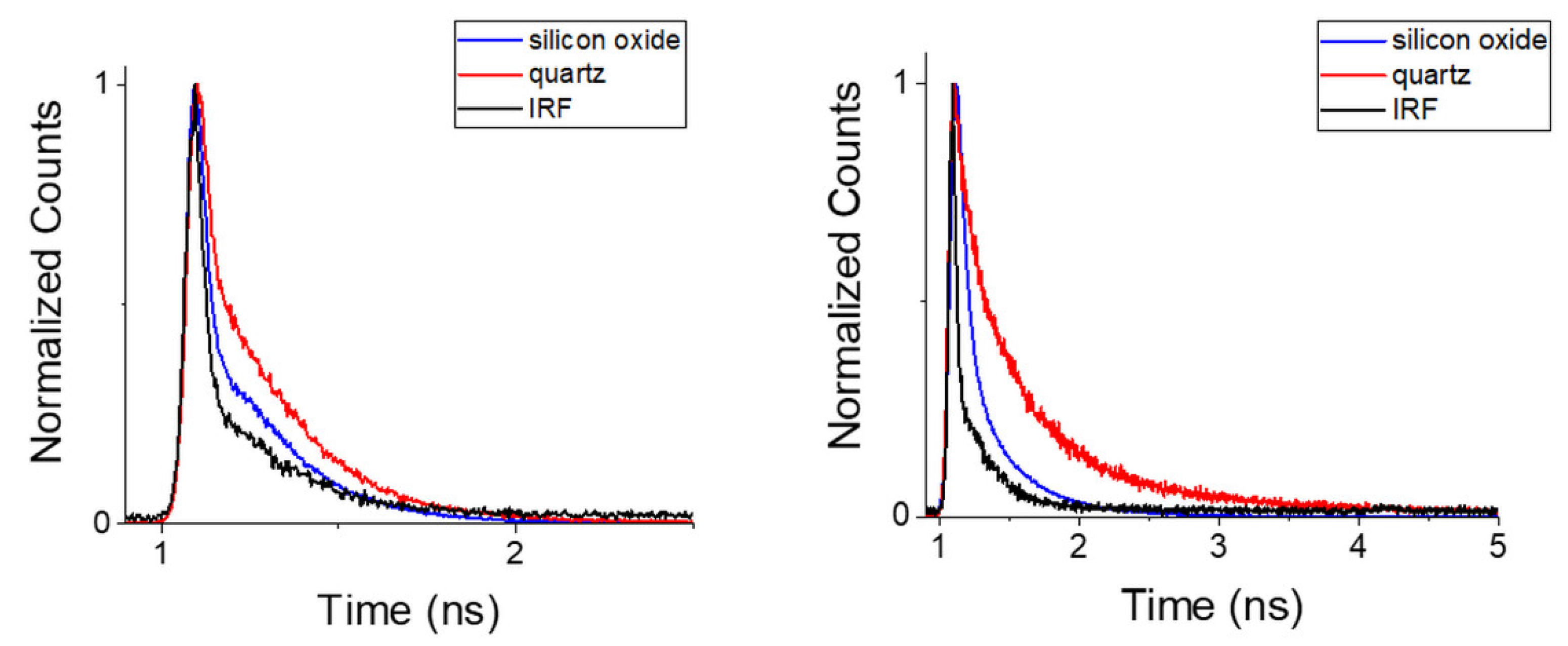
2.4. Stability of the Brushes

3. Materials and Methods
3.1. Materials
3.2. Methods
3.3. Synthesis of (3-Methyl-2,4-dihydrothieno[3,4-b][1,4]dioxepin-3-yl)methanol (ProDOT-OH)
3.4. Synthesis of (3-methyl-2,4-dihydrothieno[3,4-b][1,4]dioxepin-3-yl)methyl 2-methylprop-2-enoate (ProDOT-MM)
3.5. SI-ATRP of ProDOT-MM
3.6. Self-Templating Oxidative Polymerization of ProDOT-Poly(MM) Brushes
4. Conclusions
Supplementary Materials
Author Contributions
Funding
Institutional Review Board Statement
Informed Consent Statement
Data Availability Statement
Acknowledgments
Conflicts of Interest
References
- Shirakawa, H.; Louis, E.J.; MacDiarmid, A.G.; Chiang, C.K.; Heeger, A.J. Synthesis of Electrically Conducting Organic Polymers: Halogen Derivatives of Polyacetylene, (CH) X. J. Chem. Soc. Chem. Commun. 1977, 16, 578–580. [Google Scholar] [CrossRef]
- Szuwarzyński, M.; Wolski, K.; Kruk, T.; Zapotoczny, S. Macromolecular Strategies for Transporting Electrons and Excitation Energy in Ordered Polymer Layers. Prog. Polym. Sci. 2021, 121, 101433. [Google Scholar] [CrossRef]
- Murad, A.R.; Iraqi, A.; Aziz, S.B.; Abdullah, S.N.; Brza, M.A. Conducting Polymers for Optoelectronic Devices and Organic Solar Cells: A Review. Polymers 2020, 12, 2627. [Google Scholar] [CrossRef] [PubMed]
- Luo, L.; Huang, W.; Yang, C.; Zhang, J.; Zhang, Q. Recent Advances on π-Conjugated Polymers as Active Elements in High Performance Organic Field-Effect Transistors. Front. Phys. 2021, 16, 33500. [Google Scholar] [CrossRef]
- Tatum, W.K.; Luscombe, C.K. π-Conjugated Polymer Nanowires: Advances and Perspectives toward Effective Commercial Implementation. Polym. J. 2018, 50, 659–669. [Google Scholar] [CrossRef]
- Bergqvist, J.; Österberg, T.; Melianas, A.; Ever Aguirre, L.; Tang, Z.; Cai, W.; Ma, Z.; Kemerink, M.; Gedefaw, D.; Andersson, M.R.; et al. Asymmetric Photocurrent Extraction in Semitransparent Laminated Flexible Organic Solar Cells. NPJ Flex. Electron. 2018, 2, 4. [Google Scholar] [CrossRef] [Green Version]
- Tropp, J.; Rivnay, J. Design of Biodegradable and Biocompatible Conjugated Polymers for Bioelectronics. J. Mater. Chem. C 2021, 9, 13543–13556. [Google Scholar] [CrossRef]
- Zhuang, B.; Wang, X.; Zhang, Q.; Liu, J.; Jin, Y.; Wang, H. Nanoengineering of Poly(3,4-Ethylenedioxythiophene) for Boosting Electrochemical Applications. Sol. Energy Mater. Sol. Cells 2021, 232, 111357. [Google Scholar] [CrossRef]
- Barawi, M.; Collado, L.; Gomez-Mendoza, M.; Oropeza, F.E.; Liras, M.; Peña O’Shea, V.A. Conjugated Porous Polymers: Ground-Breaking Materials for Solar Energy Conversion. Adv. Energy Mater. 2021, 11, 2101530. [Google Scholar] [CrossRef]
- Zeglio, E.; Inganäs, O. Active Materials for Organic Electrochemical Transistors. Adv. Mater. 2018, 30, 1800941. [Google Scholar] [CrossRef]
- Louis, B.; Caubergh, S.; Larsson, P.-O.; Tian, Y.; Scheblykin, I.G. Light and Oxygen Induce Chain Scission of Conjugated Polymers in Solution. Phys. Chem. Chem. Phys. 2018, 20, 1829–1837. [Google Scholar] [CrossRef]
- Sahoo, D.; Tian, Y.; Sforazzini, G.; Anderson, H.L.; Scheblykin, I.G. Photo-Induced Fluorescence Quenching in Conjugated Polymers Dispersed in Solid Matrices at Low Concentration. J. Mater. Chem. C 2014, 2, 6601–6608. [Google Scholar] [CrossRef]
- Lin, H.; Tabaei, S.R.; Thomsson, D.; Mirzov, O.; Larsson, P.-O.; Scheblykin, I.G. Fluorescence Blinking, Exciton Dynamics, and Energy Transfer Domains in Single Conjugated Polymer Chains. J. Am. Chem. Soc. 2008, 130, 7042–7051. [Google Scholar] [CrossRef]
- Brédas, J.-L.; Beljonne, D.; Coropceanu, V.; Cornil, J. Charge-Transfer and Energy-Transfer Processes in π-Conjugated Oligomers and Polymers: A Molecular Picture. Chem. Rev. 2004, 104, 4971–5003. [Google Scholar] [CrossRef]
- Hu, D.; Yu, J.; Wong, K.; Bagchi, B.; Rossky, P.J.; Barbara, P.F. Collapse of Stiff Conjugated Polymers with Chemical Defects into Ordered, Cylindrical Conformations. Nature 2000, 405, 1030–1033. [Google Scholar] [CrossRef]
- Dos Santos, D.A.; Brédas, J.L. Influence of Polymerization Irregularities on the Electronic Properties of Polythiophene. J. Chem. Phys. 1991, 95, 6567–6575. [Google Scholar] [CrossRef]
- Kaloni, T.P.; Giesbrecht, P.K.; Schreckenbach, G.; Freund, M.S. Polythiophene: From Fundamental Perspectives to Applications. Chem. Mater. 2017, 29, 10248–10283. [Google Scholar] [CrossRef]
- Kaloni, T.P.; Schreckenbach, G.; Freund, M.S. Structural and Electronic Properties of Pristine and Doped Polythiophene: Periodic versus Molecular Calculations. J. Phys. Chem. C 2015, 119, 3979–3989. [Google Scholar] [CrossRef] [Green Version]
- Moreira, T.; Maria, F.D.; Zangoli, M.; Fabiano, E.; Manet, I.; Mazzaro, R.; Morandi, V.; Marinelli, M.; Gigli, G.; Parola, A.J.; et al. Processable Thiophene-Based Polymers with Tailored Electronic Properties and Their Application in Solid-State Electrochromic Devices Using Nanoparticle Films. Adv. Electron. Mater. 2021, 7, 2100166. [Google Scholar] [CrossRef]
- Nezakati, T.; Seifalian, A.; Tan, A.; Seifalian, A.M. Conductive Polymers: Opportunities and Challenges in Biomedical Applications. Chem. Rev. 2018, 118, 6766–6843. [Google Scholar] [CrossRef]
- Martin, D.C. Molecular Design, Synthesis, and Characterization of Conjugated Polymers for Interfacing Electronic Biomedical Devices with Living Tissue. MRS Commun. 2015, 5, 131–153. [Google Scholar] [CrossRef]
- Kvarnström, C.; Neugebauer, H.; Blomquist, S.; Ahonen, H.J.; Kankare, J.; Ivaska, A. In Situ Spectroelectrochemical Characterization of Poly(3,4-Ethylenedioxythiophene). Electrochim. Acta 1999, 44, 2739–2750. [Google Scholar] [CrossRef]
- Groenendaal, L.; Jonas, F.; Freitag, D.; Pielartzik, H.; Reynolds, J.R. Poly(3,4-Ethylenedioxythiophene) and Its Derivatives: Past, Present, and Future. Adv. Mater. 2000, 12, 481–494. [Google Scholar] [CrossRef]
- Fagiolari, L.; Varaia, E.; Mariotti, N.; Bonomo, M.; Barolo, C.; Bella, F. Poly(3,4-Ethylenedioxythiophene) in Dye-Sensitized Solar Cells: Toward Solid-State and Platinum-Free Photovoltaics. Adv. Sustain. Syst. 2021, 5, 2100025. [Google Scholar] [CrossRef]
- Fabretto, M.V.; Evans, D.R.; Mueller, M.; Zuber, K.; Hojati-Talemi, P.; Short, R.D.; Wallace, G.G.; Murphy, P.J. Polymeric Material with Metal-Like Conductivity for Next Generation Organic Electronic Devices. Chem. Mater. 2012, 24, 3998–4003. [Google Scholar] [CrossRef]
- Xia, Y.; Sun, K.; Ouyang, J. Solution-Processed Metallic Conducting Polymer Films as Transparent Electrode of Optoelectronic Devices. Adv. Mater. 2012, 24, 2436–2440. [Google Scholar] [CrossRef] [PubMed]
- Sun, K.; Zhang, S.; Li, P.; Xia, Y.; Zhang, X.; Du, D.; Isikgor, F.H.; Ouyang, J. Review on Application of PEDOTs and PEDOT:PSS in Energy Conversion and Storage Devices. J. Mater. Sci. Mater. Electron. 2015, 26, 4438–4462. [Google Scholar] [CrossRef]
- Van De Ruit, K.; Katsouras, I.; Bollen, D.; Van Mol, T.; Janssen, R.A.J.; De Leeuw, D.M.; Kemerink, M. The Curious Out-of-Plane Conductivity of PEDOT:PSS. Adv. Funct. Mater. 2013, 23, 5787–5793. [Google Scholar] [CrossRef]
- Nardes, A.M.; Kemerink, M.; Janssen, R.A.J. Anisotropic Hopping Conduction in Spin-Coated PEDOT:PSS Thin Films. Phys. Rev. B 2007, 76, 085208. [Google Scholar] [CrossRef] [Green Version]
- Kumar, A.; Welsh, D.M.; Morvant, M.C.; Piroux, F.; Abboud, K.A.; Reynolds, J.R. Conducting Poly(3,4-Alkylenedioxythiophene) Derivatives as Fast Electrochromics with High-Contrast Ratios. Chem. Mater. 1998, 10, 896–902. [Google Scholar] [CrossRef]
- Goel, M.; Siegert, M.; Krauss, G.; Mohanraj, J.; Hochgesang, A.; Heinrich, D.C.; Fried, M.; Pflaum, J.; Thelakkat, M. HOMO–HOMO Electron Transfer: An Elegant Strategy for P-Type Doping of Polymer Semiconductors toward Thermoelectric Applications. Adv. Mater. 2020, 32, 2003596. [Google Scholar] [CrossRef]
- Boyle, C.J.; Upadhyaya, M.; Wang, P.; Renna, L.A.; Lu-Díaz, M.; Pyo Jeong, S.; Hight-Huf, N.; Korugic-Karasz, L.; Barnes, M.D.; Aksamija, Z.; et al. Tuning Charge Transport Dynamics via Clustering of Doping in Organic Semiconductor Thin Films. Nat. Commun. 2019, 10, 2827. [Google Scholar] [CrossRef] [Green Version]
- Liang, Z.; Boland, M.J.; Butrouna, K.; Strachan, D.R.; Graham, K.R. Increased Power Factors of Organic-Inorganic Nanocomposite Thermoelectric Materials and the Role of Energy Filtering. J. Mater. Chem. A 2017, 5, 15891–15900. [Google Scholar] [CrossRef]
- Mazaheripour, A.; Thomas, E.M.; Segalman, R.A.; Chabinyc, M.L. Nonaggregating Doped Polymers Based on Poly(3,4-Propylenedioxythiophene). Macromolecules 2019, 52, 2203–2213. [Google Scholar] [CrossRef]
- Kiefer, D.; Kroon, R.; Hofmann, A.I.; Sun, H.; Liu, X.; Giovannitti, A.; Stegerer, D.; Cano, A.; Hynynen, J.; Yu, L.; et al. Double Doping of Conjugated Polymers with Monomer Molecular Dopants. Nat. Mater. 2019, 18, 149–155. [Google Scholar] [CrossRef] [Green Version]
- Choudhary, K.; Chen, A.X.; Pitch, G.M.; Runser, R.; Urbina, A.; Dunn, T.J.; Kodur, M.; Kleinschmidt, A.T.; Wang, B.G.; Bunch, J.A.; et al. Comparison of the Mechanical Properties of a Conjugated Polymer Deposited Using Spin Coating, Interfacial Spreading, Solution Shearing, and Spray Coating. ACS Appl. Mater. Interfaces 2021, 13, 51436–51446. [Google Scholar] [CrossRef]
- Ivanko, I.; Pánek, J.; Svoboda, J.; Zhigunov, A.; Tomšík, E. Tuning the Photoluminescence and Anisotropic Structure of PEDOT. J. Mater. Chem. C 2019, 7, 7013–7019. [Google Scholar] [CrossRef]
- Gueye, M.N.; Carella, A.; Faure-Vincent, J.; Demadrille, R.; Simonato, J.P. Progress in Understanding Structure and Transport Properties of PEDOT-Based Materials: A Critical Review. Prog. Mater. Sci. 2020, 108, 100616. [Google Scholar] [CrossRef]
- Wójcik, A.J.; Wolski, K.; Zapotoczny, S. Double-stranded surface-grafted polymer brushes with ladder-like architecture. Eur. Polym. J. 2021, 155, 110577. [Google Scholar] [CrossRef]
- Wolski, K.; Gruszkiewicz, A.; Wytrwal-Sarna, M.; Bernasik, A.; Zapotoczny, S. The Grafting Density and Thickness of Polythiophene-Based Brushes Determine the Orientation, Conjugation Length and Stability of the Grafted Chains. Polym. Chem. 2017, 8, 6250–6262. [Google Scholar] [CrossRef]
- Zoppe, J.O.; Ataman, N.C.; Mocny, P.; Wang, J.; Moraes, J.; Klok, H.A. Surface-Initiated Controlled Radical Polymerization: State-of-the-Art, Opportunities, and Challenges in Surface and Interface Engineering with Polymer Brushes. Chem. Rev. 2017, 117, 1105–1318. [Google Scholar] [CrossRef] [PubMed] [Green Version]
- Sontag, S.K.; Sheppard, G.R.; Usselman, N.M.; Marshall, N.; Locklin, J. Surface-Confined Nickel Mediated Cross-Coupling Reactions: Characterization of Initiator Environment in Kumada Catalyst-Transfer Polycondensation. Langmuir 2011, 27, 12033–12041. [Google Scholar] [CrossRef] [PubMed]
- Doubina, N.; Jenkins, J.L.; Paniagua, S.A.; Mazzio, K.A.; Macdonald, G.A.; Jen, A.K.; Armstrong, N.R.; Marder, S.R.; Luscombe, C.K. Surface-Initiated Synthesis of Poly(3-Methylthiophene) from Indium Tin Oxide and Its Electrochemical Properties. Langmuir 2012, 28, 1900–1908. [Google Scholar] [CrossRef] [PubMed]
- Sontag, S.K.; Marshall, N.; Locklin, J. Formation of Conjugated Polymer Brushes by Surface-Initiated Catalyst-Transfer Polycondensation. Chem. Commun. 2009, 23, 3354. [Google Scholar] [CrossRef] [PubMed]
- Villemin, E.; Lemarque, B.; Vũ, T.T.; Nguyen, V.Q.; Trippé-Allard, G.; Martin, P.; Lacaze, P.-C.; Lacroix, J.-C. Improved Adhesion of Poly(3,4-Ethylenedioxythiophene) (PEDOT) Thin Film to Solid Substrates Using Electrografted Promoters and Application to Efficient Nanoplasmonic Devices. Synth. Met. 2019, 248, 45–52. [Google Scholar] [CrossRef]
- Wei, B.; Liu, J.; Ouyang, L.; Kuo, C.-C.; Martin, D.C. Significant Enhancement of PEDOT Thin Film Adhesion to Inorganic Solid Substrates with EDOT-Acid. ACS Appl. Mater. Interfaces 2015, 7, 15388–15394. [Google Scholar] [CrossRef]
- Yang, M.; Yang, T.; Deng, H.; Wang, J.; Ning, S.; Li, X.; Ren, X.; Su, Y.; Zang, J.; Li, X.; et al. Poly(5-Nitroindole) Thin Film as Conductive and Adhesive Interfacial Layer for Robust Neural Interface. Adv. Funct. Mater. 2021, 31, 2105857. [Google Scholar] [CrossRef]
- Yavuz, M.S.; Sotzing, G.A. Surface Grafting of Electrochemically Crosslinked Poly(3,4- Ethylenedioxythiophene) (PEDOT) Brushes via Surface-Initiated Ring-Opening Metathesis Polymerization. Eur. Polym. J. 2012, 48, 875–880. [Google Scholar] [CrossRef]
- Barbey, R.; Lavanant, L.; Paripovic, D.; Schüwer, N.; Sugnaux, C.; Tugulu, S.; Klok, H.A. Polymer Brushes via Surface-Initiated Controlled Radical Polymerization: Synthesis, Characterization, Properties, and Applications. Chem. Rev. 2009, 109, 5437–5527. [Google Scholar] [CrossRef]
- Wolski, K.; Gruszkiewicz, A.; Zapotoczny, S. Conductive Polythiophene-Based Brushes Grafted from an ITO Surface via a Self-Templating Approach. Polym. Chem. 2015, 6, 7505–7513. [Google Scholar] [CrossRef]
- Wolski, K.; Szuwarzyński, M.; Zapotoczny, S. A Facile Route to Electronically Conductive Polyelectrolyte Brushes as Platforms of Molecular Wires. Chem. Sci. 2015, 6, 1754–1760. [Google Scholar] [CrossRef] [Green Version]
- Szuwarzyński, M.; Kowal, J.; Zapotoczny, S. Self-Templating Surface-Initiated Polymerization: A Route to Synthesize Conductive Brushes. J. Mater. Chem. 2012, 22, 20179–20181. [Google Scholar] [CrossRef]
- Szuwarzyński, M.; Wolski, K.; Zapotoczny, S. Enhanced Stability of Conductive Polyacetylene in Ladder-like Surface-Grafted Brushes. Polym. Chem. 2016, 7, 5664–5670. [Google Scholar] [CrossRef]
- Kim, J.; Kim, B.; Anand, C.; Mano, A.; Zaidi, J.S.M.; Ariga, K.; You, J.; Vinu, A.; Kim, E. A Single-Step Synthesis of Electroactive Mesoporous ProDOT-Silica Structures. Angew. Chemie-Int. Ed. 2015, 54, 8407–8410. [Google Scholar] [CrossRef]
- Xue, Y.; Xue, Z.; Zhang, W.; Zhang, W.; Chen, S.; Lin, K.; Xu, J. Effects on Optoelectronic Performances of EDOT End-Capped Oligomers and Electrochromic Polymers by Varying Thienothiophene Cores. J. Electroanal. Chem. 2019, 834, 150–160. [Google Scholar] [CrossRef]
- Ghosh, S.; Kouame, N.A.; Remita, S.; Ramos, L.; Goubard, F.; Aubert, P.-H.; Dazzi, A.; Deniset-Besseau, A.; Remita, H. Visible-Light Active Conducting Polymer Nanostructures with Superior Photocatalytic Activity. Sci. Rep. 2016, 5, 18002. [Google Scholar] [CrossRef] [Green Version]
- Hu, C.W.; Yamada, Y.; Yoshimura, K. Poly(3,4-Alkylenedioxythiophenes): PXDOTs Electrochromic Polymers as Gasochromic Materials. Sol. Energy Mater. Sol. Cells 2018, 187, 30–38. [Google Scholar] [CrossRef]
- Matyjaszewski, K. Advanced Materials by Atom Transfer Radical Polymerization. Adv. Mater. 2018, 30, 1706441. [Google Scholar] [CrossRef]
- Tang, W.; Kwak, Y.; Braunecker, W.; Tsarevsky, N.V.; Coote, M.L.; Matyjaszewski, K. Understanding Atom Transfer Radical Polymerization: Effect of Ligand and Initiator Structures on the Equilibrium Constants. J. Am. Chem. Soc. 2008, 130, 10702–10713. [Google Scholar] [CrossRef]
- Ye, J.; Narain, R. Water-Assisted Atom Transfer Radical Polymerization of N-Isopropylacrylamide: Nature of Solvent and Temperature. J. Phys. Chem. B 2009, 113, 676–681. [Google Scholar] [CrossRef]
- Senthilkumar, B.; Thenamirtham, P.; Kalai Selvan, R. Structural and Electrochemical Properties of Polythiophene. Appl. Surf. Sci. 2011, 257, 9063–9067. [Google Scholar] [CrossRef]
- Guo, J.; André, P.; Adam, M.; Panyukov, S.; Rubinstein, M.; Desimone, J.M. Solution Properties of a Fluorinated Alkyl Methacrylate Polymer in Carbon Dioxide. Macromolecules 2006, 39, 3427–3434. [Google Scholar] [CrossRef]
- Słowikowska, M.; Wolski, K.; Wójcik, A.J.; Wesner, D.; Schönherr, H.; Zapotoczny, S. Unraveling the Nanomechanical Properties of Surface-Grafted Conjugated Polymer Brushes with Ladder-like Architecture. Polym. Chem. 2020, 11, 7050–7062. [Google Scholar] [CrossRef]
- Brédas, J.L.; Silbey, R. (Eds.) Conjugated Polymers; Springer: Dordrecht, The Netherlands, 1991; ISBN 978-94-010-5536-9. [Google Scholar]
- Wei, B.; Ouyang, L.; Liu, J.; Martin, D.C. Post-Polymerization Functionalization of Poly(3,4-Propylenedioxythiophene) (PProDOT) via Thiol-Ene “Click” Chemistry. J. Mater. Chem. B 2015, 3, 5028–5034. [Google Scholar] [CrossRef] [PubMed] [Green Version]
- Wei, B.; Liu, J.; Ouyang, L.; Martin, D.C. POSS-ProDOT Crosslinking of PEDOT. J. Mater. Chem. B 2017, 5, 5019–5026. [Google Scholar] [CrossRef]
- Meerholz, K.; Heinze, J. Multiple Reversible Electrochemical Reduction of Aromatic Hydrocarbons in Liquid Alkylamines. J. Am. Chem. Soc. 1989, 111, 2325–2326. [Google Scholar] [CrossRef]
- Huddleston, N.E.; Sontag, S.K.; Bilbrey, J.A.; Sheppard, G.R.; Locklin, J. Palladium-Mediated Surface-Initiated Kumada Catalyst Polycondensation: A Facile Route Towards Oriented Conjugated Polymers. Macromol. Rapid Commun. 2012, 33, 2115–2120. [Google Scholar] [CrossRef]
- Izumi, T.; Kobashi, S.; Takimiya, K.; Aso, Y.; Otsubo, T. Synthesis and Spectroscopic Properties of a Series of β-Blocked Long Oligothiophenes up to the 96-Mer: Revaluation of Effective Conjugation Length. J. Am. Chem. Soc. 2003, 125, 5286–5287. [Google Scholar] [CrossRef]
- Dai, Q.; Li, Y.; Zhai, L.; Sun, W. 3,4-Ethylenedioxythiophene (EDOT)-Based π-Conjugated Oligomers: Facile Synthesis and Excited-State Properties. J. Photochem. Photobiol. A Chem. 2009, 206, 164–168. [Google Scholar] [CrossRef]
- Becker, R.S.; De Seixas Mélo, J.; Maçanita, A.L.; Eliseil, F. Comprehensive Evaluation of the Absorption, Photophysical, Energy Transfer, Structural, and Theoretical Properties of Ct-Oligothiophenes with One to Seven Rings. J. Phys. Chem. 1996, 100, 18683–18695. [Google Scholar] [CrossRef] [Green Version]
- Sharnoff, M. Photophysics of Aromatic Molecules. J. Lumin. 1971, 4, 69–71. [Google Scholar] [CrossRef]
- Aoyama, Y.; Yamanari, T.; Koumura, N.; Tachikawa, H.; Nagai, M.; Yoshida, Y. Photo-Induced Oxidation of Polythiophene Derivatives: Dependence on Side Chain Structure. Polym. Degrad. Stab. 2013, 98, 899–903. [Google Scholar] [CrossRef]
- Manceau, M.; Rivaton, A.; Gardette, J.L.; Guillerez, S.; Lemaître, N. The Mechanism of Photo- and Thermooxidation of Poly(3-Hexylthiophene) (P3HT) Reconsidered. Polym. Degrad. Stab. 2009, 94, 898–907. [Google Scholar] [CrossRef]
- Fišerová, E.; Kubala, M. Mean Fluorescence Lifetime and Its Error. J. Lumin. 2012, 132, 2059–2064. [Google Scholar] [CrossRef]
- Frisch, M.J.; Trucks, G.W.; Schlegel, H.B.; Scuseria, G.E.; Robb, M.A.; Cheeseman, J.R.; Scalmani, G.; Barone, V.; Petersson, G.A.; Nakatsuji, H.; et al. Gaussian 16, Revision B.01; Gaussian, Inc.: Wallingford, CT, USA, 2016. [Google Scholar]
- Becke, A.D. Density-Functional Thermochemistry. III. The Role of Exact Exchange. J. Chem. Phys. 1993, 98, 5648–5656. [Google Scholar] [CrossRef] [Green Version]
- Lee, C.; Yang, W.; Parr, R.G. Development of the Colle-Salvetti Correlation-Energy Formula into a Functional of the Electron Density. Phys. Rev. B 1988, 37, 785–789. [Google Scholar] [CrossRef] [Green Version]
- Stephens, P.J.; Devlin, F.J.; Chabalowski, C.F.; Frisch, M.J. Ab Initio Calculation of Vibrational Absorption and Circular Dichroism Spectra Using Density Functional Force Fields. J. Phys. Chem. 1994, 98, 11623–11627. [Google Scholar] [CrossRef]
- Dunning, T.H. Gaussian Basis Sets for Use in Correlated Molecular Calculations. I. The Atoms Boron through Neon and Hydrogen. J. Chem. Phys. 1989, 90, 1007–1023. [Google Scholar] [CrossRef]


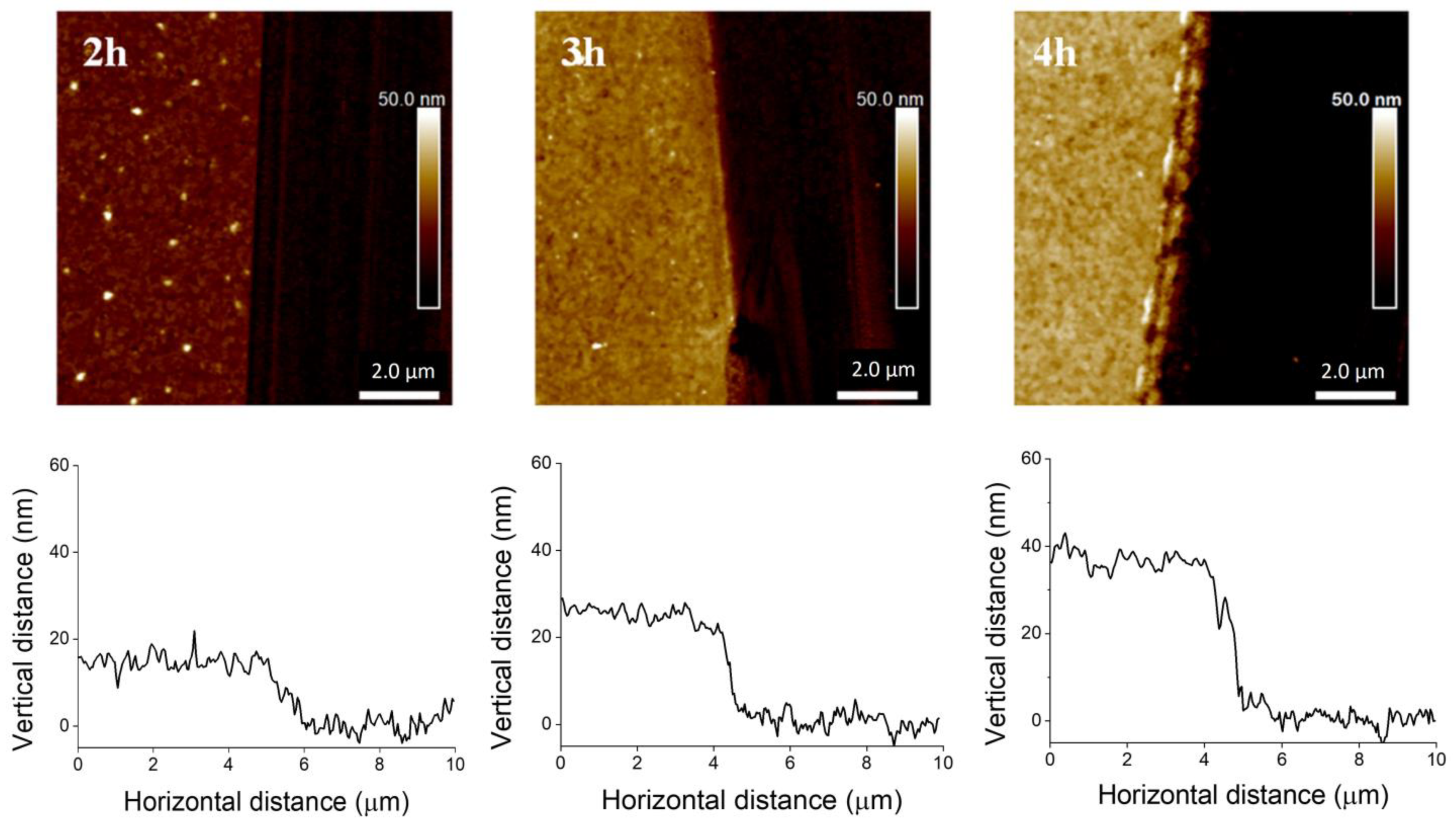
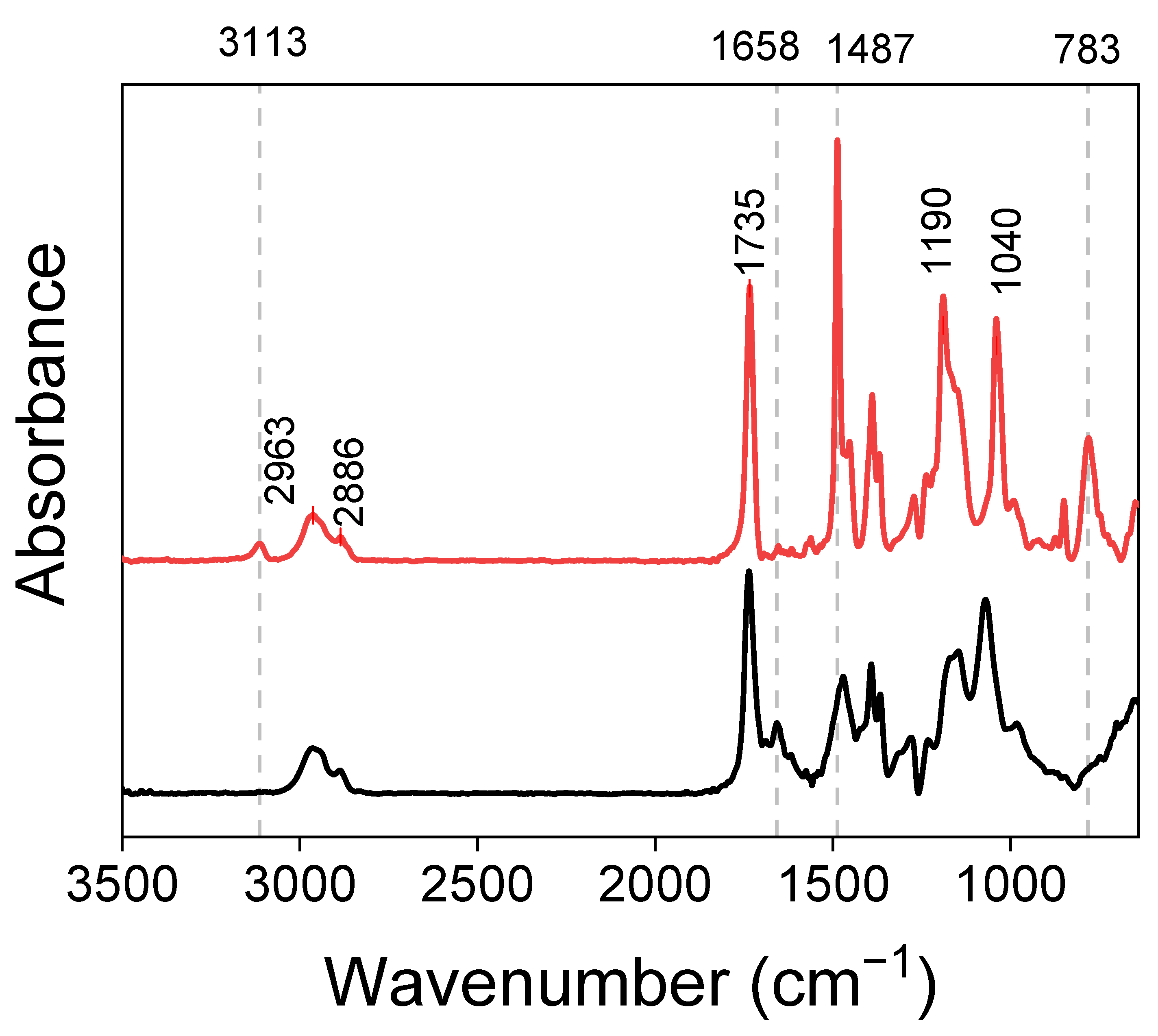
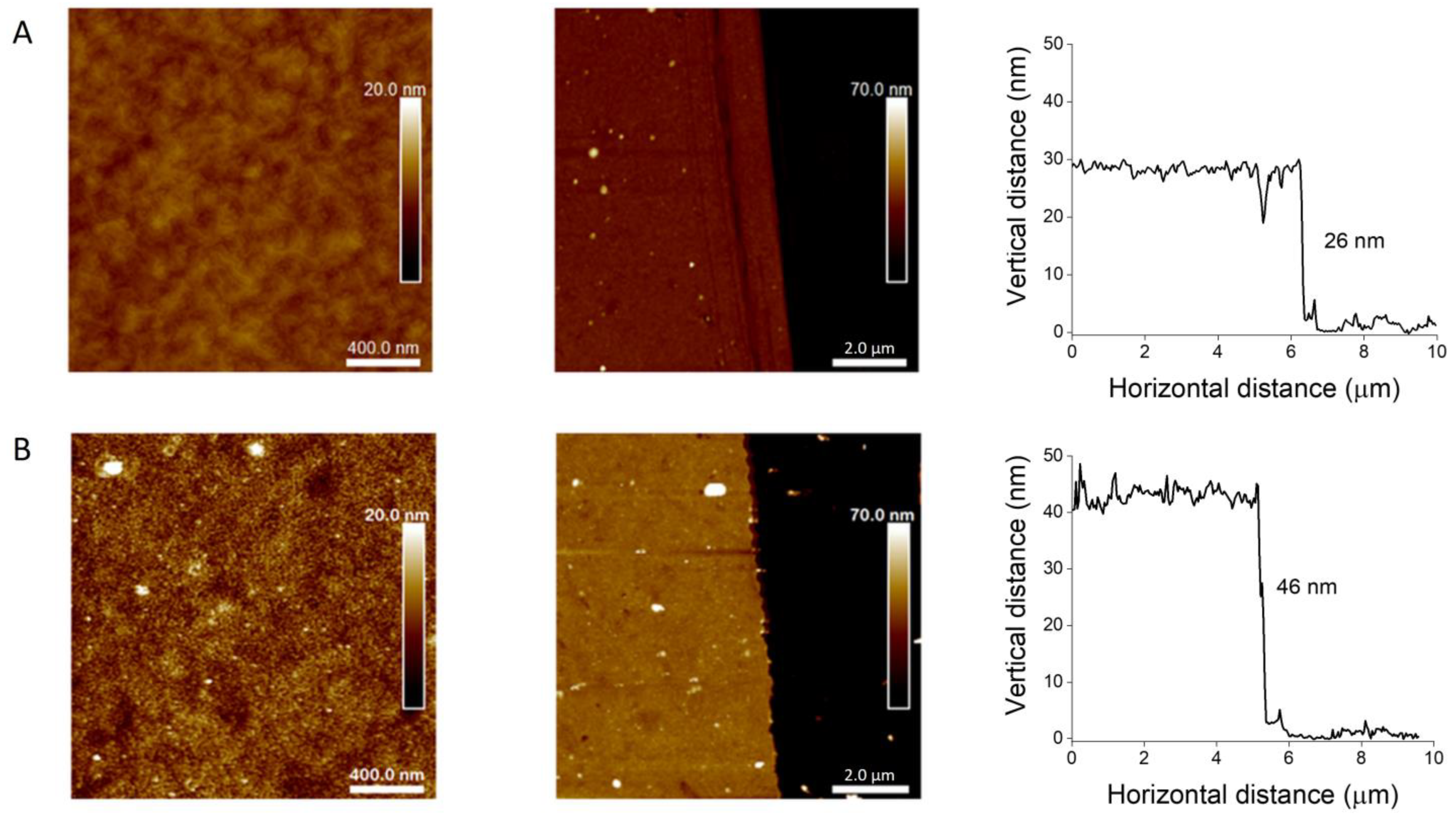

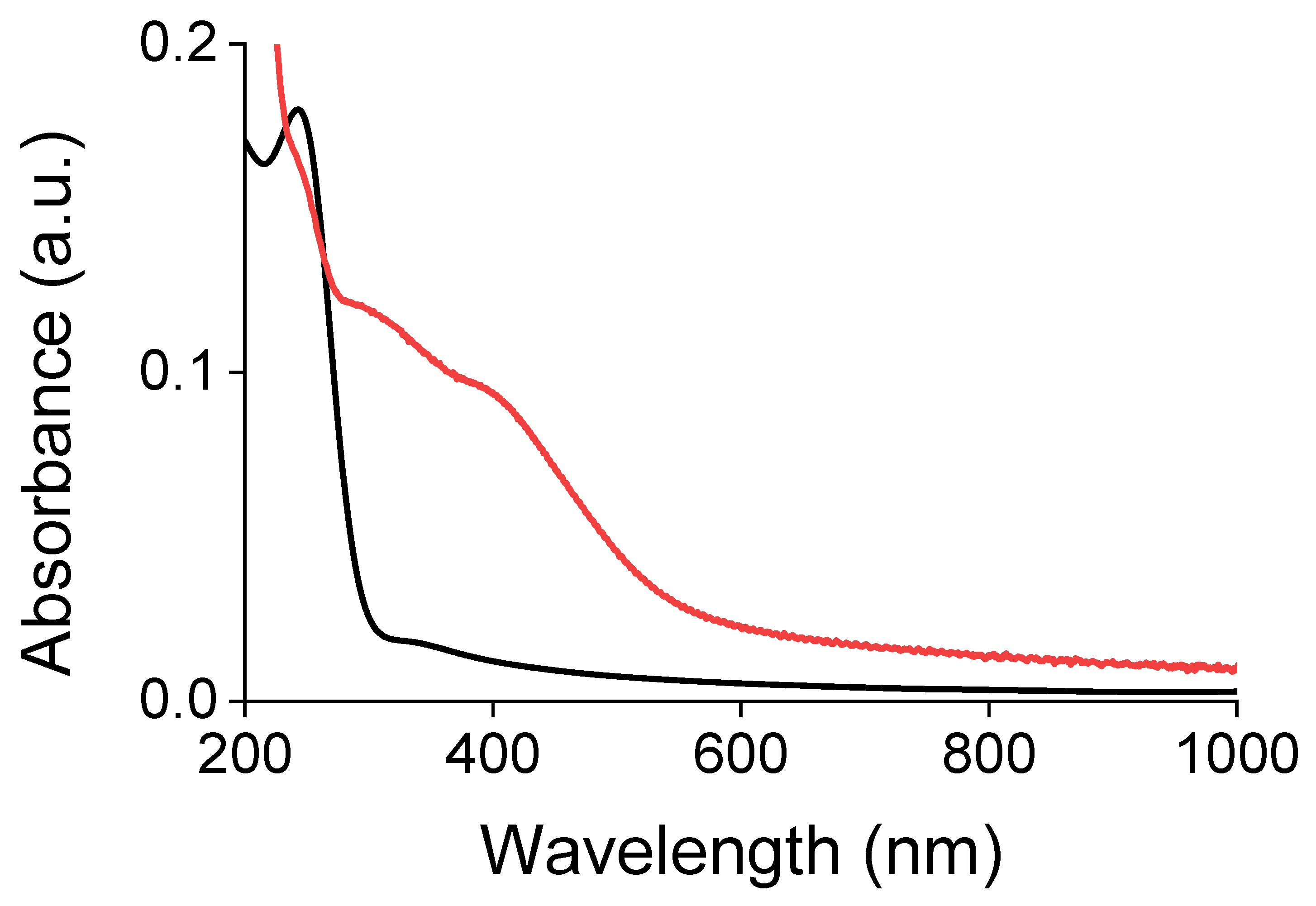

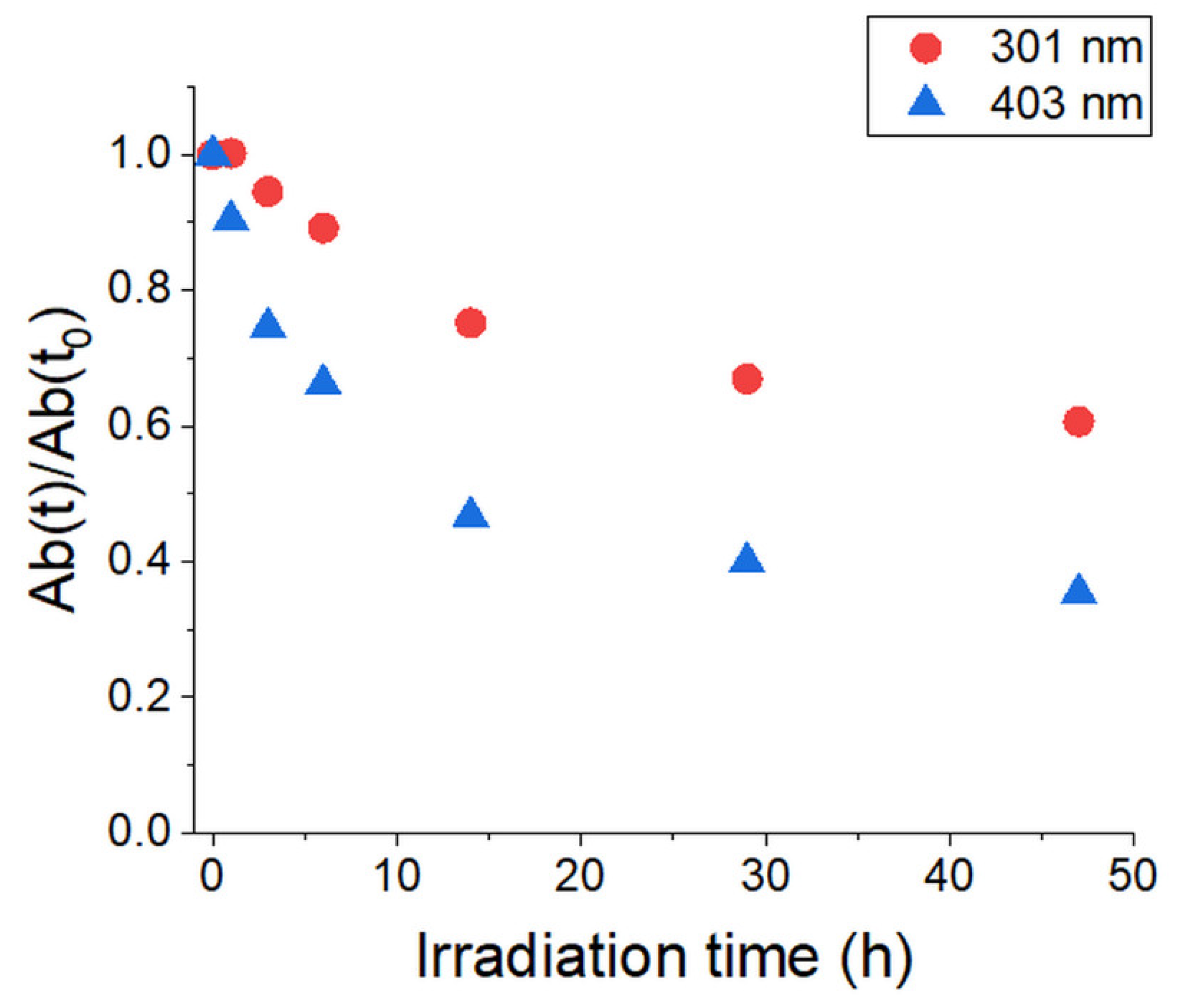
| Solvent Composition: DMF/Water a | Time of Polymerization | Thickness of ProDOT-Poly(MM) Brushes |
|---|---|---|
| 95/5 | 2 h | 14 ± 2 nm |
| 95/5 | 3 h | 24 ± 1 nm |
| 95/5 | 4 h | 36 ± 2 nm |
| 100/0 | 10 h | 14 ± 2 nm |
| 100/0 | 22 h | 39 ± 4 nm |
| Theoretical Atomic Concentration (%) | Atomic Concentration of ProDOT-Poly(MM) (%) | Atomic Concentration of Poly(ProDOT)-Poly(MM) (%) | |
|---|---|---|---|
| C | 72.2 | 69.8 | 69.0 |
| O | 22.2 | 23.9 | 24.8 |
| S | 5.6 | 6.3 | 6.0 |
| Fe | - | - | 0.1 |
| Cl | - | - | 0.1 |
Publisher’s Note: MDPI stays neutral with regard to jurisdictional claims in published maps and institutional affiliations. |
© 2022 by the authors. Licensee MDPI, Basel, Switzerland. This article is an open access article distributed under the terms and conditions of the Creative Commons Attribution (CC BY) license (https://creativecommons.org/licenses/by/4.0/).
Share and Cite
Grześ, G.; Wolski, K.; Uchacz, T.; Bała, J.; Louis, B.; Scheblykin, I.G.; Zapotoczny, S. Ladder-like Polymer Brushes Containing Conjugated Poly(Propylenedioxythiophene) Chains. Int. J. Mol. Sci. 2022, 23, 5886. https://doi.org/10.3390/ijms23115886
Grześ G, Wolski K, Uchacz T, Bała J, Louis B, Scheblykin IG, Zapotoczny S. Ladder-like Polymer Brushes Containing Conjugated Poly(Propylenedioxythiophene) Chains. International Journal of Molecular Sciences. 2022; 23(11):5886. https://doi.org/10.3390/ijms23115886
Chicago/Turabian StyleGrześ, Gabriela, Karol Wolski, Tomasz Uchacz, Justyna Bała, Boris Louis, Ivan G. Scheblykin, and Szczepan Zapotoczny. 2022. "Ladder-like Polymer Brushes Containing Conjugated Poly(Propylenedioxythiophene) Chains" International Journal of Molecular Sciences 23, no. 11: 5886. https://doi.org/10.3390/ijms23115886
APA StyleGrześ, G., Wolski, K., Uchacz, T., Bała, J., Louis, B., Scheblykin, I. G., & Zapotoczny, S. (2022). Ladder-like Polymer Brushes Containing Conjugated Poly(Propylenedioxythiophene) Chains. International Journal of Molecular Sciences, 23(11), 5886. https://doi.org/10.3390/ijms23115886








